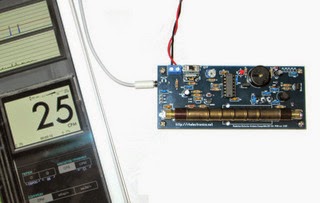The
video shows HV tests with Philips 18504 Geiger tube. It
demonstrate HV stability and current consumption under low and high
radiation load. As you can
see, the HV stays within plateau limits even under very high count load.
No drops and no over-voltage on the tube.To perform the same experiment
you need to build 10 Giga ohm voltage divider for the multimeter. Such
high impedance exclude any effect on HV converter and allows to measure
HV correctly.
Technical specifications of Philips 18504:
Initializing Voltage: 275V-325V
Beginning of Plateau: 425V
Ending of Plateau: 650V
The kit was configured for 500V output with jumper. High
voltage was measured on the point after 1N4937 diodes multiplier before
4.7M load resistor.
18504
tube has mica window that allows to demonstrate very intensive
radiation load count when Am-241 sample placed closely to mica. The
distance between mica surface and Am-241 was less than 1.00mm. High
speed count under this condition is identical to 1200uSv/h Gamma
radiation load, or at least it simulates extremely high load count
conditions.




